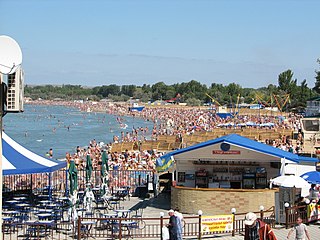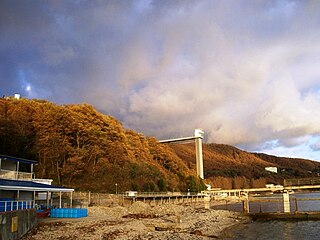
Murad V (21 September 1840 – 29 August 1904) was the 33rd Sultan of the Ottoman Empire who reigned from 30 May to 31 August 1876.
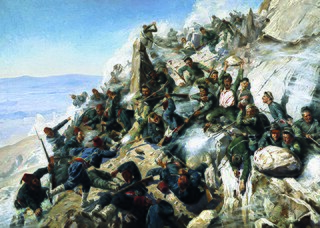
The Russo-Turkish War of 1877–78 was a conflict between the Ottoman Empire and the Eastern Orthodox coalition led by the Russian Empire and composed of Bulgaria, Romania, Serbia, and Montenegro. Fought in the Balkans and in the Caucasus, it originated in emerging 19th-century Balkan nationalism. Additional factors combined Russian goals of recovering territorial losses endured during the Crimean War, re-establishing itself in the Black Sea and supporting the political movement attempting to free Balkan nations from the Ottoman Empire.

The Russo-Turkish War of 1828–1829 was sparked by the Greek War of Independence. The war broke out after the Sultan closed the Dardanelles to Russian ships and revoked the Akkerman Convention in retaliation for Russian participation in the Battle of Navarino.

The Russo-Turkish War (1806–1812) between the Russian Empire and the Ottoman Empire was one of the Russo-Turkish Wars.
The Ubykh are one of the twelve Adyghe (Circassian) tribes, representing one of the twelve stars on the green-and-gold Adyghe flag. Along with the Natukhai and Shapsug tribes, the Ubykh were one of three coastal Adyghe tribes to form the Circassian Assembly in 1860. Historically, they spoke a distinct Ubykh language, which never existed in written form and went extinct in 1992 when Tevfik Esenç, the last speaker, died.

The Armistice of Mudros, concluded on 30 October 1918, ended the hostilities, at noon the next day, in the Middle Eastern theatre between the Ottoman Empire and the Allies of World War I. It was signed by the Ottoman Minister of Marine Affairs Rauf Bey and the British Admiral Somerset Arthur Gough-Calthorpe, on board HMS Agamemnon in Moudros harbor on the Greek island of Lemnos.

Azov Cossack Host was a Cossack host that existed on the northern shore of the Sea of Azov, between 1832 and 1862.

Kabardia was a historical region in the North Caucasus corresponding partly to the modern Kabardino-Balkaria. It had better political organization than its neighbors and a somewhat ‘feudal’ social structure. It existed as a political community from the fifteenth century or earlier until it came under Russian control in the early nineteenth century.
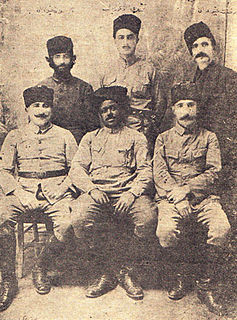
The Karakol society, was a Turkish clandestine intelligence organization that fought on the side of the Turkish National Movement during the Turkish War of Independence. Formed in November 1918, it refused to merge itself with Association for the Defense of the Rights of Anatolia and Rumelia under Mustafa Kemal Atatürk. Its leadership was decapitated in the aftermath of the Turkish Grand National Assembly election, 1920, leading to its eventual dissolution in 1926.

The Circassian genocide was the Russian Empire's ethnic cleansing, killing, forced migration, and expulsion of the majority of the Circassians from their historical homeland Circassia, which roughly encompassed the major part of the North Caucasus and the northeast shore of the Black Sea. This occurred in the aftermath of the Caucasian War in the last quarter of the 19th century. The displaced people moved primarily to the Ottoman Empire.
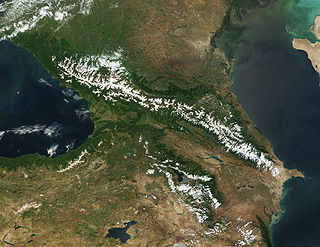
The Russian conquest of the Caucasus mainly occurred between 1800 and 1864. In that era the Russian Empire expanded to control the region between the Black Sea and Caspian Sea, the territory that is modern Armenia, Azerbaijan, Georgia, and parts of Iran and Turkey, as well as the North Caucasus region of modern Russia. Multiple wars were fought against the local rulers of the regions, as well as the dominant powers, the Ottoman Empire and Persian Empire, for control. By 1864 the last regions were brought under Russian control.
The mission of the Vixen was a conflict between the Russian Empire and the United Kingdom that occurred in 1836.

Circassian nationalism is the desire among Circassians to reestablish an independent Circassian state in Circassia, which lost its independence in the Russian–Circassian War. Many of its themes involve the repatriation of diaspora Circassians and the revitalization of the Adyghe language.
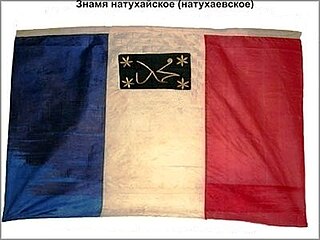
The Natukhai are one of the twelve main Adyghe tribes. Their areas historically extended along the Black Sea coast from Anapa in the north to Tsemes Bay in the south and from the north side of the mountains to the lower Kuban River.

Russian Black Sea Coast also rarely Circassian coast was the coast of historical Circassia on the Black Sea before 1864, extending from Anapa in the North to Adler in the south, and including cities like Tuapse and Sochi.

Ğazı II Giray was a khan of the Crimean Khanate. Born in 1554, he distinguished himself in the Ottoman–Safavid War (1578–90), gaining the trust of his Ottoman suzerains. He was appointed khan in 1588, after his homeland experienced a period of political turmoil. He failed to capture Moscow during his 1591 campaign against Tsardom of Russia, however he managed to secure a favorable peace treaty two years later. He was then summoned to support his Ottoman allies in the Long Turkish War, taking part in multiple military expeditions centered in Hungary. In late 1596, the Ottoman sultan briefly unseated Ğazı II Giray in favor of Fetih I Giray after heeding the advice of Grand Vizier Cığalazade Yusuf Sinan Pasha. He returned to power three months later, continuing his reign until his death in November 1607.

Muḥammad Bey Abū aḏ-Ḏahab (1735–1775), also just called Abū Ḏahab, was a Mamluk emir and regent of Ottoman Egypt.



